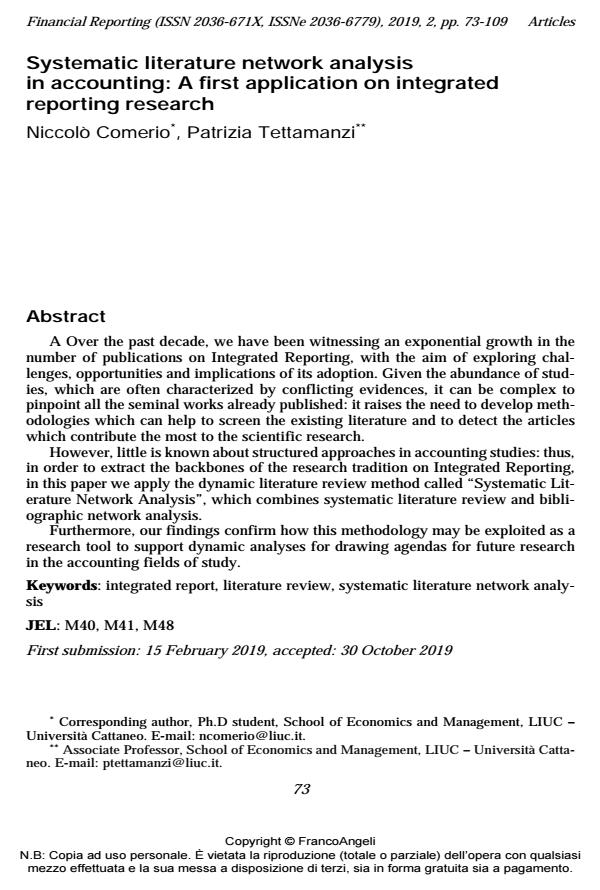Systematic literature network analysis in accounting: A first application on integrated reporting research
Titolo Rivista FINANCIAL REPORTING
Autori/Curatori Niccolò Comerio, Patrizia Tettamanzi
Anno di pubblicazione 2019 Fascicolo 2019/2
Lingua Inglese Numero pagine 38 P. 73-95 Dimensione file 255 KB
DOI 10.3280/FR2019-002004
Il DOI è il codice a barre della proprietà intellettuale: per saperne di più
clicca qui
Qui sotto puoi vedere in anteprima la prima pagina di questo articolo.
Se questo articolo ti interessa, lo puoi acquistare (e scaricare in formato pdf) seguendo le facili indicazioni per acquistare il download credit. Acquista Download Credits per scaricare questo Articolo in formato PDF

FrancoAngeli è membro della Publishers International Linking Association, Inc (PILA)associazione indipendente e non profit per facilitare (attraverso i servizi tecnologici implementati da CrossRef.org) l’accesso degli studiosi ai contenuti digitali nelle pubblicazioni professionali e scientifiche
A Over the past decade, we have been witnessing an exponential growth in the number of publications on Integrated Reporting, with the aim of exploring challenges, opportunities and implications of its adoption. Given the abundance of studies, which are often characterized by conflicting evidences, it can be complex to pinpoint all the seminal works already published: it raises the need to develop methodologies which can help to screen the existing literature and to detect the articles which contribute the most to the scientific research. However, little is known about structured approaches in accounting studies: thus, in order to extract the backbones of the research tradition on Integrated Reporting, in this paper we apply the dynamic literature review method called "Systematic Literature Network Analysis", which combines systematic literature review and bibliographic network analysis. Furthermore, our findings confirm how this methodology may be exploited as a research tool to support dynamic analyses for drawing agendas for future research in the accounting fields of study.
Parole chiave:Integrated report, literature review, systematic literature network analysis
Jel codes:M40, M41, M48
- The transition toward sustainability of airport operators. Evidence from Italy Antonio Thomas, Giuseppe Scandurra, in Journal of Air Transport Management 102470/2023 pp.102470
DOI: 10.1016/j.jairtraman.2023.102470 - Do audit committee attributes influence integrated reporting quality? An agency theory viewpoint Nicola Raimo, Filippo Vitolla, Arcangelo Marrone, Michele Rubino, in Business Strategy and the Environment /2021 pp.522
DOI: 10.1002/bse.2635 - The quality of nonfinancial voluntary disclosure: A systematic literature network analysis on sustainability reporting and integrated reporting Valentina Minutiello, Patrizia Tettamanzi, in Corporate Social Responsibility and Environmental Management /2022 pp.1
DOI: 10.1002/csr.2195 - The value relevance of corporate financial and nonfinancial information provided by the integrated report: A systematic review Stefania Veltri, Antonella Silvestri, in Business Strategy and the Environment /2020 pp.3038
DOI: 10.1002/bse.2556 - The Development of Non-Financial Reporting Valentina Minutiello, Anna Lucia Missaglia, Patrizia Tettamanzi, pp.1 (ISBN:978-3-031-83180-5)
- Differences in Disclosure of Integrated Reports at Energy and Non-Energy Companies Maja Piesiewicz, Marlena Ciechan-Kujawa, Paweł Kufel, in Energies /2021 pp.1253
DOI: 10.3390/en14051253
Niccolò Comerio, Patrizia Tettamanzi, Systematic literature network analysis in accounting: A first application on integrated reporting research in "FINANCIAL REPORTING" 2/2019, pp 73-95, DOI: 10.3280/FR2019-002004